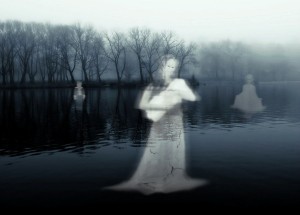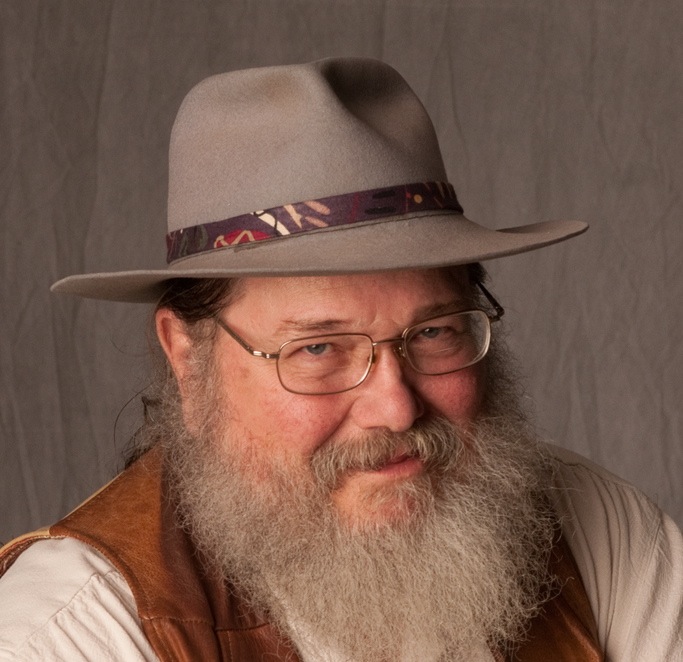Author’s note: “From a live performance, best if read aloud.”
Better than 100 years ago Flagstaff, my rough and tumble frontier town, had more saloons than churches. There was a young woman named Maria. Maria was probably the best looking girl in northern Arizona and she knew it. She would talk to her abuelita, her little grandmother: “When I marry, I am going to marry the most handsome cowboy. He will have hair as black as a raven’s wing and moustaches that come down and curve up on the end.”
“Maria,” her grandmother would warn her, “don’t be so concerned with appearances. When it comes time to choose a husband, look for a man that is a good father and a good provider. Don’t worry if he is the most handsome.” But Maria knew what she wanted. One day, she was in downtown Flagstaff in front of the Babbitt trading post. She was looking at a dress in the window that had just come in from the east on the train. She said to herself, “Maria that dress would really look good on you.” As Maria was admiring the dress, she was also admiring her own refection in the window.
She thought, Whoee, Maria, you looking good today, girl! In her reflection, she could see behind her coming down the main street of Flagstaff, a young cowboy, muy guapo, mounted on a half-wild stallion. The horse was tossing its head, and its long mane and tail were flying through the air. The young cowboy had hair as black as a raven’s wing and moustaches that hung way down and curled up at the tip. You may find this hard to believe, but the young cowboy was even more handsome than me. When the young cowboy saw Maria, he stepped off his horse and tipped his hat and said, “I would like to visit you at your home.” Maria said, “I guess you could.”
The young cowboy began to pay court to Maria. He would show up at her house with a bouquet of wild flowers he had picked on the prairie, or a small bag of hard candy. By and by, they fell in love and got married. Maria’s family gave the young couple a beautiful new house that stood on the banks of the Rio de Flag, right where the little wooden bridge crosses by the town library today. For several years things went well for Maria. They had two little children and lived happily on the banks of the Rio de Flag. But her husband began to go back to his cowboy ways. He would ride off to Winslow and be gone three days, or he would ride to Prescott and be gone a week and come home broke, smelling of liquor and once, she thought he smelled perfume.
Then came the day the cowboy did not return to Maria and the two little children. Maria was all alone. One summer day she stood outside, during monsoon season, and looked toward the Peaks and watched the big white clouds piling up. She knew that soon it would rain. She looked off toward Flagstaff and saw a buggy approaching. As the buggy pulled nearer, she could see her husband was the driver, and seated beside him was another woman. A woman that had flaming red hair, piled high and was wearing just a little too much makeup.
“I don’t even want to speak to you,” he said. “I’m just here to see my children.” And he went into the house. VABOOM. The thunder clapped and the lightening flashed and it began to rain. The rain came down and the water rose in the Rio. Maria stood there, wet to the bone. She watched as her husband came out of the house, and walked right past her without speaking. He got in the buggy and drove away. Boom de boom boom. The thunder crashed and something in Maria snapped. Maria went crazy. Crazy with anger, crazy with jealousy that her husband had come to see the children and ignored her. Maria did a horrible thing. She took her two precious children and threw them into the raging Rio. When she realized what she had done, she began to run along the banks of the swollen stream, crying, “Mis hijos! Mis hijos!” But it was too late. The children had been swept away.
As Maria ran along, she tripped and fell, striking her head against a large white rock. The next day, when the people went out to assess the storm damage, they found the bodies of the two little children. And they found Maria, where she fell. The priest said the children should be buried in the campo santo, the holy ground of the cemetery, but Maria had murdered her children and then taken her own life so she could not be buried in holy ground. So they buried Maria right there beside the Rio where she died.
In the years after, people began to report seeing a figure all dressed in white walking through the trees along the Rio at night. And people said they could hear the figure crying, “Mis hijos. Mis hijos,” and they began to call her La Llorona, the crying woman. Mothers would try to scare their children into behaving by saying, you better get home on time or La Llorona will get you.
I want to tell you about one time. It was a summer night and children were playing along the creek. The shadows were getting long and the sun was going down. It was beginning to get dark and they heard a sound.
“Suppertime, suppertime.” All across Flagstaff, mothers were calling their children home for dinner. One by one they said, “There’s my mom. I gotta go.” But one little boy, kind of a tough little boy, did not go home. He was having fun. He wanted to play. “I’m going to sit right here on this big white rock and watch the full moon rise.” And that’s just what he did. As he was watching the big full moon rise above the pine trees, he noticed a figure, all dressed in white, coming through the trees toward him. And he could hear her cry, “Mis hijos. Mis hijos.” And he knew it was La Llorona. Just then, the figure noticed the little boy and said, “Mi Hijo!” She stretched out her arms toward him. The boy could see that there was no flesh on the hands, just the bones of a skeleton. “Mi hijo, my son.” And she grabbed him by the shoulders. It felt like icicles digging into his flesh. He was staring into the face of La Llorona, but she didn’t have a face. It was just a skull.
The little boy could not move a muscle. Just then the bells of the church began to ring. Bong, bong, bong. The little boy remembered a prayer his abuelito told him. He prayed like he never had prayed in his life. La Llorona released him and turned and walked away along the Rio. When she disappeared, he jumped up and began to run for home. He ran so fast he hit the kitchen door. The door flew open. His mother said, “Where have you been? Supper has been on the table for 20 minutes.” “Mama,” he cried, “La Llorona!” “Don’t tell me your stories,” she said. But then she saw the bloody finger prints on his shoulder and she believed.
This little boy did not stay out late anymore. He did all his chores. He did all his homework. He was the best behaved boy in Flagstaff. But if you were to go to his home, his mother would bring out the shirt and show you the fingerprints in blood of La Llorona. They still say that if you are walking along the Rio on a moonlit night, you may hear a sound. At first, you’ll think it is the sound of the wind in the pine trees. But if you listen closely, you will hear “Mis hijos. Mis hijos,” and that will be La Llorona looking for her children.


